#wor research and inspo
Text
Thinking about returning to my NPR (nonphotorealistic rendering) research for my WOR style guide thingy.
Fell off of it last year, but since I'm working on these three characters here, it's important to remind myself of the goals for WOR's style.
Also, need to make a moodboard and media example list for WOR's fantasy 3D/2D aesthetic.
With this said, guess what I found recently!
So, I was revisiting an old webcomic I had read in my teens called The Dreamland Chronicles by Scott Christian Sava. This site is currently an archive of the 3D comic series that started in 2006. If you visit, just know that some of the pages, both the old 3D comic and the 2016 drawn comic, are either missing or misplaced throughout the site. I'm not sure if this site is still updated or maintained.
I found a series of pages that explained how The Dreamland Chronicles was made. Pages start here! This gives me a good starting point for developing and designing 3D characters, environments, and assets for a comic. The only thing that's missing is the render time (the style is similar to most 3D animation during the early 2000s on a 3D Studio Max version during that time) and how they organize all the files.



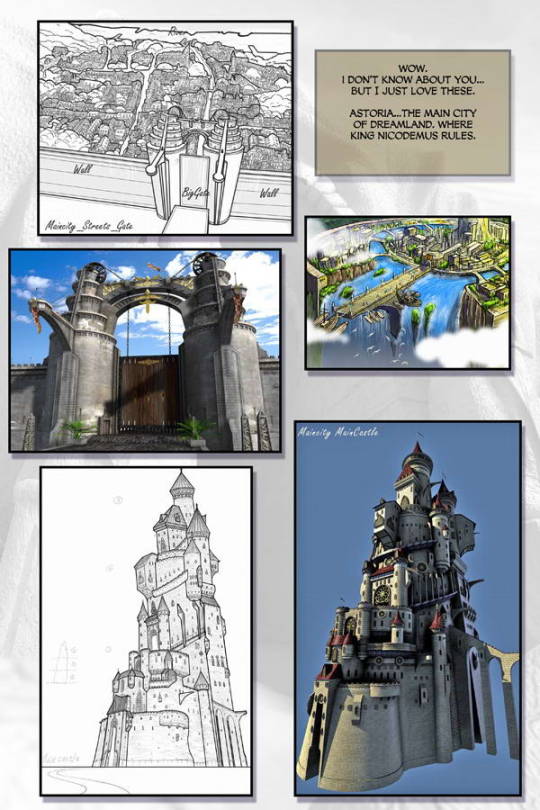
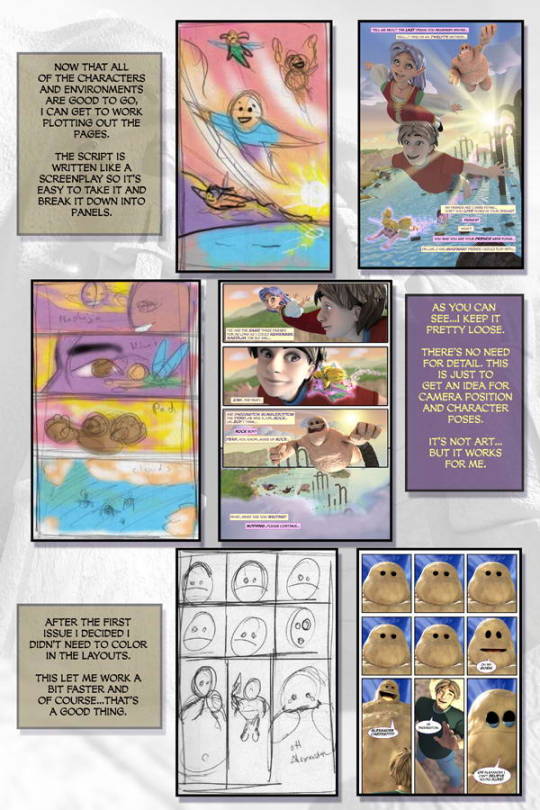

I did check the comments under one of these pages on the site and the creator did mention that (mind you, this was back in 2008 with 2000s 3D software) it took either a few hours or days to render a single frame. Nowadays, Blender, Maya, 3D Studio Max, and other 3D software are more advanced, so something like this would take half the time on a good computer rig.
Got some more information about the comic from the FAQ section here. It's no longer on the main site, but still accessible on the Wayback Machine.
What I found interesting is that once all the characters, sets, environments, and other assets are completed, it takes about a day or so to create a page. Depending on what the scene calls for, maybe more pages created within a day. Back when Dreamland Chronicles was running, the comic updates five times per week.
~ I mean, still, there's render time. So maybe, pages were created one week, then rendered out while the next pages were created, and so on?
Considering this comic's semi-realism style, yeah, that render time is going to take a while.
For WOR's style, I'm going for a cel-shaded 3D style similar to my own drawn style.
Example, my Spoon Ballerina character from last year, from concept to 3D model. Note: the 3D render on the right was less than a minute for a single character and plane using EVEE (Blender 4.0).

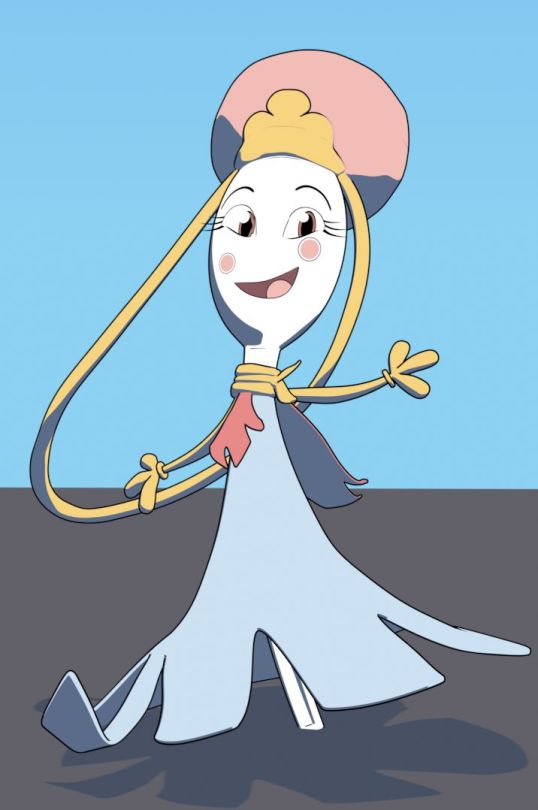
Another example is the anime 3D models by Bran Sculpts like the one below:
youtube
Both examples use Blender, and while Bran uses Blender's emission shader nodes to create the flat colors and shadows (with painted shadows), the Lightning Boy Shader I use also works off of emission nodes. Lightning Boy has the advantage of layer shader nodes, thus simplifying the setup for more complex models. The painted shadows I might had to do for certain areas of the character depending on how they are lit in an environment.
Rendering time might not take long for these- hang on
Downloaded and rendered the Akko rig - in less than half a minute. That's just with one character, tho, how long would it take with a full scene with a fully modeled environment? Idk, but maybe time might not be an issue for this style lol. And the character models might not need a high poly count for rendering, either. Interesting!
The most time-consuming thing I could see for WOR's style is modeling and texturing (gods, humans, all mimic/war and civilian object types, assets, environments, etc) per issue for Rise of Relics (maybe for months depending). Setting up for a scene (for panels and so on) might not take long at all...
#mystuff#npr#nonphotorealistic rendering#blender#blender 3d#3ds max#dreamland chronicles#webcomics#3d modeling#wor research and inspo#worldofrelics research notes#worldofrelics#art#bran scuplts#Youtube
1 note
·
View note
Text
I like how everyone's doing a marketable plushy for their projects and brands and here I am trying to think up a way to raise money to get some blacksmith in his backyard to forge a lifesize sword replica of my sword oc Prince Luther.
Also, when I say blacksmith I mean this guy:
youtube
#michaelcthulhu#swordsmithing#blacksmithing#wor research and inspo#this is like...literally what Luther is#a big rectangle sword#fucking iron slab blade#I mean considering the size of all my sword ocs they are basically the same thing lol#Youtube
0 notes
Text
Looking up the Devonian Period Dunkleosteus fish because SCARY MASSIVE JAWs:

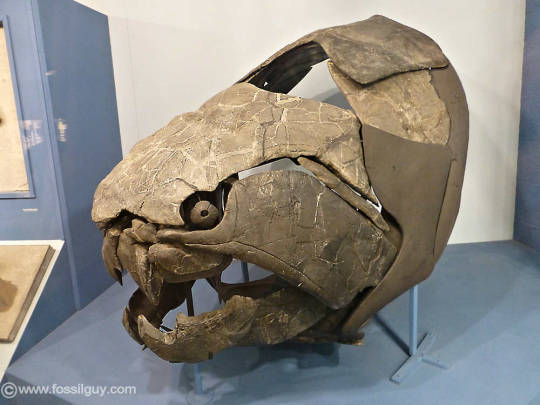
Terrifying beautiful fish creature, it was.
33 notes
·
View notes
Text
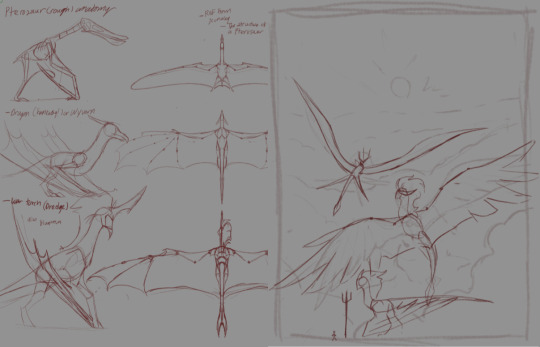
I'm back working on Altostratus' cover with Queen Nike (she/her) and Flammagenitus (she/they)! The thumbnail sketch for the cover is on the right, and on the left are quick anatomy sketches of a pterosaur, wyvern, and modern dredge war-torch.
Long lore post, more notes below!
So, initially, I wanted Flammagenitus to have large feathered wings made of metal. But I had no idea how to translate "feathered wings" to "armored wings" in her visual design. There's, like, a lot of stuff I need yet to figure out about the design of my WOR objectocs in Rise of Relics and The Mundane Realm settings: what era their forms would be the most common, how contflict, resources, and other factors affect the how living objects develop their civilian, worker, and war object groups, and so on. Then there are the cultures that inspired these elements and how to best represent them, even as inspiration for fantasy worldbuilding about talking object people. Something I really need to take time to sit down and think about before going deeper into writing.
I mean, I'm already knee-deep in it, but I'm welcome to rewrite stuff.
Anyway, I do know from my worldbuilding that the first living objects had cores that looked close to their original non-living forms before the Inversion Event. So, Nikey in RFR is just a trident with some mild modifications to allow ichor to create her face and wings, or at least the ichor structure to support her cloth wings. In centuries after the Inversion Event, objects and relics developed modifications to customize their cores, thus the Refitting Process was born.
Without going on too long, the Refitting Process was popular among the relics during the Age of Relics (0-500 AFR). The Hidden Age (500-1800 THA) was when the Refitting Process peaked during the Relic Wars, a time in which relickind fought amongst themselves over the fate of objectkind. The relics used refitting to make themselves more powerful, massive, and greater than their smaller forms. Led by the Great Spear Apollyon, some relics believed their lost divinity could be remade through this process. However, not all relics desired this and rather want to put an end to this war. Queen Nike worked with objectkind to build a powerful weapon to destroy the enemy relics. That weapon was Flammagentius, the first war-torch refitted from a living paintbrush.
:D Lore dumping yay! (Date format might change later, tho)
Anyway, so about Flammagenitus' design: well they are huge, I think I have their current size to be around 2080.2cm/68 feet…might update it later but yeah she's big. Since they were designed by Queen Nike and her relics, along with objectkind, there might be possible influence from Nike's culture prior to the Inversion Event.
Nike, or originally NIkey, was an Antiquan goddess. Her home, Antiqua, was inspired by Ancient Greece (around the Hellenistic period maybe need to look at my notes later ahhh). You can see her goddess form here! She was based on the Greek goddess Nike, the Goddess of Victory, and her goddess design was based on the Greek Hoplite.
So, for ideas of Flammagenitus' and future war-torch design:
Influence will be heavily Ancient Greece due to Queen Nike, but might borrow a few things from Ancient Rome since Flammagentius is a future ruler of Jazera (Rome inspired) which later splintered into smaller kingdoms after her death.
Greek helmets such as the Attic, Corinthian, or Chalcidian styles for her head design. Needs to allow some room for her jaw to move for her devastating killer bite.
Pterosaur-inspired wing design with a little bit of dragon in it. Also, using the pterosaur anatomy with the arms for greater support for Flammagenitus' heavy fuselage(?) and the ichor engine within it. Modern dredge war-torches have lighter construction but still have a heavy ichor engine.
Sidenote: Ichor engines are powered by unfettered ichor harvested from the ichor wells, deep pits in the earth full of ichor. It's the same thing that living objects have for limbs, but it contains enormous amounts of energy trapped within it. Can't be consumed or else it will cause Burnout (a condition that kills a living object with uncontrolled magic)
The modern dredge war-torch mentioned earlier in this post will come about two thousand years later, its role is to cause as much damage to castles and fortresses or to fight other dredge war-torches as an anti-air defense. They, and their monolith counterparts, are smaller than Flammagentius. This is due to the relic technological magic that was used to refit Flammagentius was lost during The Relic Wars. A refitted core that Flammagentius had would put far too much stress on a dredge's ichor structure, increasing the chance of internal damage.
Here are some war-torch designs with more bird-like anatomy from last year. These I might use for smaller war-torches for aerial attacks in battle.


Might do more research on the wing thing or I can just default to ichor limbs shifting into wing appendages. We'll see.
#worldofrelics#objectxenofiction#my art#wip#objectoc#sketches#wyvern#pterosaur#speculative biology#greek art#worldbuilding#worldbuilding notes#dragon#war-torch#wor research and inspo reblogs
8 notes
·
View notes
Text
Trying to figure out how to ask a HEMA instructor how a living sword that levitates and use itself to fight other living swords would work. Also, how a human would fight a giant living sword somehow without being horribly stabbed or crushed. (Possibly not survivable, but might make for fun action scenes for the rare human/war object encounter)
There's a HEMA organization in Atlanta sooo it might not hurt to send an email.
There are also historical fencing manuals out there for using swords and daggers, polearms, and such. I need to check those out, too.
Oh, swords in my setting range from human height to (maybe) 15ft (I don't have my notes with me lol). I haven't figured out weight yet. It's going to be important for the float mechanics in WOR's setting.
#objectoc#swordfighting#worldbuilding#HEMA#I know it's not just swing blade stabby stabby#wor research and inspo reblogs
9 notes
·
View notes
Text
Updated my Interactions and Fanart Boundaries for World of Relics! It's still a bit of a long read, but it's worth it if you want to know what's okay or not. I did my best to clear up anything, but if you have any questions, please let me know!!! Tell me through dms or asks about what you think! Thank you!
#mystuff#worldofrelics#riseofrelics#themundanerealm#objectoc#boundaries#please respect my boundaries thanks!#art#current projects#wor research and inspo reblogs
5 notes
·
View notes
Text

Finally caved in and updated their heights.
I-I just like the idea of kaiju monster battles in my story, lol!
Anyway, Flammagentius (the largest monolithic warobject to ever be refitted) is updated from 68ft to 120-150ft range.
Nike is at the maximum height of a THA-era refitted relic, 100ft. In her unrefitted form, she was originally around 9ft-15ft as a goddess and 12ft-13ft as a living trident after the Inversion Event (AFR era).
Sizes are updated mostly because whenever I imagine a battle between Flammin and another large relic, I imagine them very very terrifyingly large.
#I need to watch godzilla ahhhhh#especially shin godzilla I heard its good#tmr nike#tmr flammin#tmr flammagenitus#themundanerealm#worldofrelics#wor research and inspo reblogs#altostratus
2 notes
·
View notes
Text

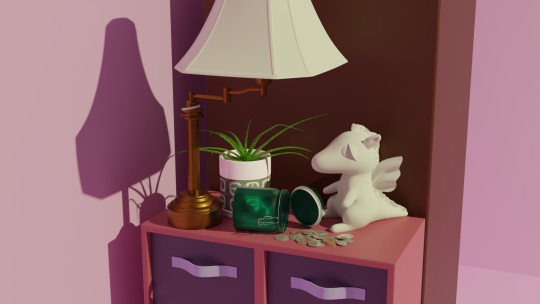
So I've been working on a 3D still life since the beginning of the year! Photo ref below!


The purpose of this still life is both to learn Blender and also to create a starting point for practicing cel-shading style for WOR!
First, create a realistic (as possible) still life using what I learned from Blender tutorials. Then research and test cel-shading styles for the still life to match my style for WOR.
Before that step, I need to create a style guide for WOR's style. So far, I have plenty of examples to base the style guide on:
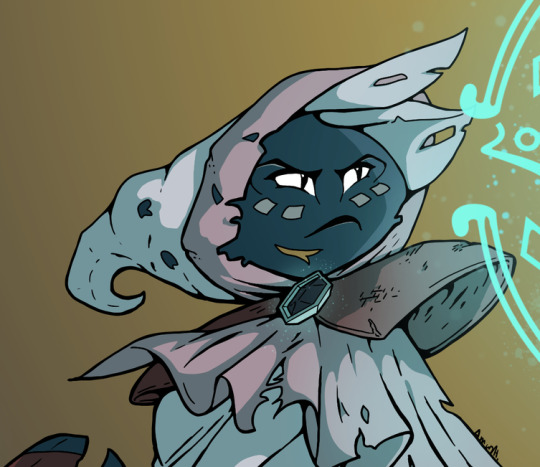



Might take me a month to create it (it's not just the characters the style guide is for, it must include backgrounds, buildings, creatures, etc).
So, what's the cel-shaded style will look like?
I'm looking at the following:
Lightning Boy Shader Tutorial from Lightning Boy Studios
Hades Behind the Scenes from Supergiant Games
Why this style??
The goal is to make things a little easier for me while I work on RFR's comic and any art for WOR's stories in the future. My current style is a little time intensive from sketch to the final image. 3D will allow me to cut time in half, providing me with either a good reference/starting point, ease of composition, and, maybe hopefully, spending more time on getting pages for RFR's comic done once I start producing it.
Still, that's a long way off (rn doing concept stuff now ahhhh), but it's something for me to explore!
Anyway, once I do a couple of successful renders from the still life, next is taking a character from my past art and recreating them using the same methods.

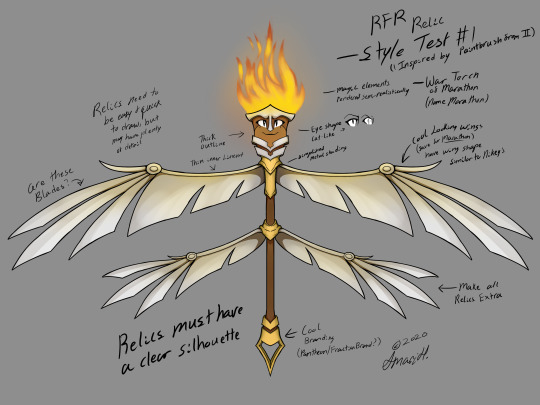
So, maybe, one of these two! Clara (not WOR related) and Not-Marathon are the simplest object ocs I have currently and are good candidates for the future style test. If successful, then either of these characters will be next:
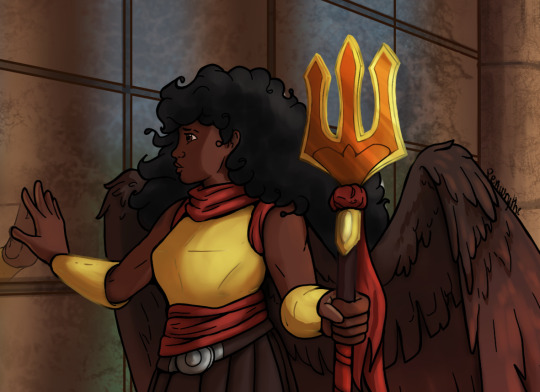

Doing a human character is very important since they still exist in WOR (just barely on the edge of extinction lol). Sylvania would be great for a more complex version of my object characters to prepare for something like a war-torch.
Anyway, that's what I've been doing! Sorry for the long post!
#tw long post#WorldofRelics#time for research#style guide#comics#3d art#3d sketch#sketch#objectoc#myart#fantasy#new adult fantasy#object xenofiction#wor research and inspo reblogs
3 notes
·
View notes
Text
Giga ultra mega late night post
So, I been working on the Spoon Ballerina for five/six days and I'm learning a lot about the process. This model is a style test before the actual style test! Once I master the 2D/3D style, I'll be set for working on RFR pages (by 2025 maybe I don't know lol)
I know I definitely need a pipeline for character and environment asset design and creation prior to producing the pages for RFR. But to streamline this, here's what I'm thinking about:
After style test, create base shaders and rigs for eyes, mouth, and other surface anatomy for my object ocs. This will allow me to easily place and modify these assets without recreating them for each character. Since most object ocs range from similar forms to more complex forms, recycling models is going to be important. Same with human/god characters, too.
Also, for human/god character models, I look into making base models with a variety of body types so I have a ready-made asset to modify for a new character.
Sculpting is going to be important for the more complex character designs and background elements, so I need to learn how to sculpt and also recycle sculpted assets.
Maybe....a process test after the style test? Say for example, for a scene, I need three living swords and five living orbs and three cloaks, along with the characters from the style test (Eightenate, Inga, and Gwenny). Three of the orbs have injuries and two cloaks (rust rot, ichor loss, burns), the other two are uninjured. The swords are helping them, one of them is a leader speaking to Eightenate, clearly more decorated with regalia and etchings as signs of their rank. In the same scene (or panel whatever) shows Inga recovering (maybe escape from the swords) speaking to two other humans about what happened. All these characters will borrow elements from each of their base characters with modifications needed for their role and design in the scene.
How long will it take for me to do modifications to the style test characters to create the new ones in this example? What about background elements?
Because, I think it might be a week or two to create the original base characters and environment elements, then a day or a couple days to modify them into the new characters. Then another for setting up the scene, rendering, and adding final touches such as color grade and affects. Final render then publishing it.
Also for some background elements, I might be able to find ready made assets on 3D modeling stores. Just do the modifications needed for the style of the comic and just import them into the scenes needed.
Oof storage space is going to be something ahhh, I'll figure it out, might get a three terabyte drive, might last me a few years, and a cloud backup system for it too
And that means finding ways to fund the comic once I get it off the ground. For paying asset plugin creators, backup services, other artists and designers if I start hiring, and so on. I have no idea for merch... maybe art books, short story anthologies, commissions, or figurines and plushies, maybe an actual sword lol (that's going to be thousands to make lol).
I'm not hiring for right now, I don't have the income to pay artists, but when I do, I'm looking for artists and designers who work in Blender, Krita, and Photoshop. They need to be 18 years or older (WOR is New Adult Fantasy; target audience is 18-25 yrs), have some familiarity with fantasy elements and ancient and medieval cultures I take inspiration from for WOR's storytelling and design, and also object shows since that is WOR's main inspiration is from.
We'll see what comes from the style test first!
#world of relics#textposty#3D#blender 3d#3D pipeline#work pipeline#objectoc#worldofrelics#characterdesign#wip#wor research and inspo reblogs
2 notes
·
View notes
Text
Huh...
I'm looking up information on Alchemy and its connection to Hermeticism.
(For context: WOR's magic system is based on Alchemy. I'm doing research to understand it better.)
The most concerning information I came across is how appropriative Modern Hermeticism, especially Hermetic Qabbalah, is to Judaism and the Kabbalah. I'm not Jewish, so a lot of this is unfamiliar to me and I am learning. I know that Kabbalah is not for non-Jews to learn as it's a sacred spiritual closed practice in Judaism. I have no intention of exploring this, but I am concerned about perpetuating an antisemitic appropriation of a close practice.
There are parts in ancient Hermeticism that tie themselves to Alchemy that I'm interested in such as the Great Work, Hermetica texts, and the Emerald Tablet. But with this said, I will tread carefully and avoid anything appropriating Jewish Kabbalah or practices. Just keep with the more ancient parts and avoid the rest of everything else. If problematic stuff pops up there, abandon that, too.
Kabbalah vs Cabala vs Qabalah by Jewitches for more info on what I'm talking about.
#writing#appropriation#any Jewish person is welcome to comment on this!#alchemy#hermeticism#cultural appropriation#wor research and inspo reblogs
2 notes
·
View notes
Text
Happy Valentine's Day!
Just saw Entergalatic, an adult animated film about Black love in New York City! Stunningly beautiful 3D animation! I wish I could screenshot some parts of the film to show how they texture and shade skincolor in this film.
youtube
#mystuff#entergalatic#entergalatic film#npr#npr 3d#3d npr#non-photorealistic rendering#wor research and inspo reblogs#texture and shading for human characters#Youtube
0 notes
Text
*Suddenly remembers the research I still need to do for the magic system in WOR*
*Also realize it's time to actually read medieval and greek texts so there's the context for the magic system*
*Also...Hephaestus makes more sense now might need to change some character names lol*
#personal#worldofrelics#quick read up on hephaestus ahhhh makes since lol#wor research and inspo reblogs
0 notes
Text
Future comic workflow thingingy IDK
One thing I totally forgot is how long it would take to model everything. Characters and backgrounds are going to take a very long time. I'm not sure how long it will take: from concept, box modeling, sculpting, UVs and texturing, and rigging. Skipping animation because comic, but it will take a while before I can even work on the comic's pages.
But once the characters and backgrounds are done, the only thing I need to worry about is thumbnail/storyboard the pages, block out each page with posed models and backgrounds, clean up poses and backgrounds, finalize with color grade and other details, then post the completed pages.
So yeah, it's going to be a lot.
Oh, and I'm still trying to find a good example of a 3D comic other than the old Dreamland Chronicles before its reboot in 2019. So far, I found another one, (comic's name cut because it's rated R, my apologies, didn't check the ratings) that looks really good. It's a painterly semi-realistic stylized comic with the 3D elements used in backgrounds. The characters I think are a combination of hand-drawn style with a 3D models occasionally used as a reference.
While writing this, I was also going through Topwebcomics.com and found The Automan's Daughter by Mike Stamm! It's a 2D/3D hybrid it looks like! I just found it but going through the first few pages, all characters are 2D while the major background elements are 3D cell-shaded, with lines that match the characters' lineart! They also do animation for another story with similar concepts, also cell-shaded: The Ottoman
0 notes
Text
This is going to be a lot
I just started doing research on various 2D-stylized 3D styles and I'm already overwhelmed. I have a list of media to look into starting with Spiderverse and ahhhhhhh so much to look into already. I know I can just pick matching media to my style, but I just want to understand what I'm getting into.
ksdjlfkdsfjksd ah! just look at this, so much information just with character design:
youtube
Check out MANIAKRA's Spiderverse analysis videos!!!!
While World of Relics is a worldbuilding/webcomic project, I'm hyped to explore this style.
#worldofrelics#jsldkjflsdjflkj;aj;lfdjskdjflsdkjf;lkja;lsdjlfsjflkjsdlkjf#get hyped#the sources just keep building so much on and on just with spiderverse#I still have like five or six more media to look into fuck#guilty gear is going to interesting ahahah#Dragon prince too#Youtube#wor research and inspo reblogs
0 notes
Text
Ohhhh! I just read a very informative article on creating 2D-inspired styles for 3D games.
This gives me a few ideas on how to proceed with both the style guide for WOR but also how to handle some parts of RFR's comic series production. I'll make a moodboard first for reference, with a collection of media with similar styles to WOR. Here's an example of my style:

Then for future style tests in 3D: I'll first work on a very simplified model, like a living rock character, then move to a more complex character, like a human/god or another living object like a war-torch.
Then, a style test of a 1-page comic. So, something like the image below. This was a comic I created last year for Gwuenevere while I was just beginning to write her story. Done in ink-wash and acrylic for the crystal.
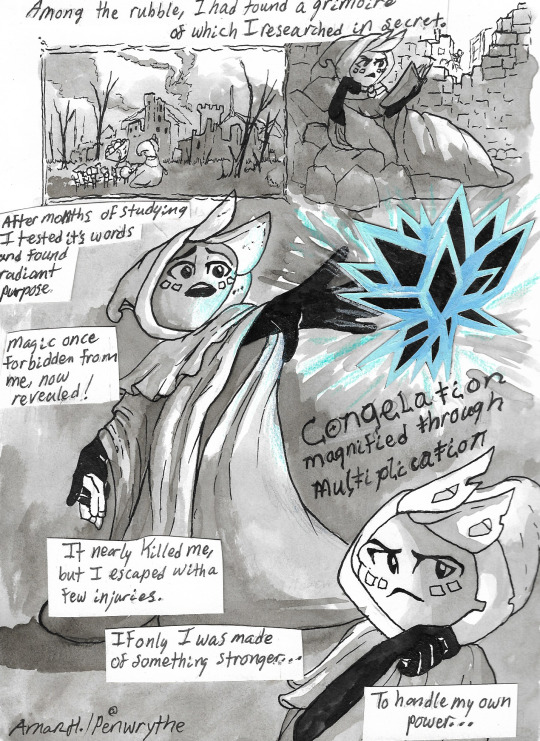
#worldofrelics#stylized 3d#development#themundanerealm#riseofrelics#objectoc#cell-shading#objectxenofiction#wor research and inspo reblogs
0 notes